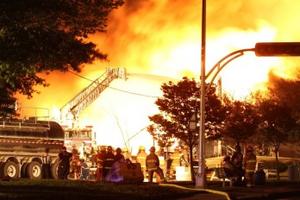Oil transportQuebec deadly accident revives pipeline vs. rail debate
The sharp increase in U.S. domestic oil production in the last four years, and the opening by the Obama administration of new areas for drilling, have greatly benefitted U.S. rail companies, which now enjoy the added business of transporting oil from places where pipelines do not exist.U.S. domestic shipments of oil have increased from 9,500 carloads in 2008 to more than 230,000 carloads last year. The deadly Lac-Megantic, Quebec crude-oil train accident revives the debate about the relative safety merits of two modes of transporting oil over long distances – rail vs. pipeline. Proponents of the Keystone XL pipeline project say the Quebec accident will boost support for their cause.

Blaze dwarfs first responders // Source: tinn.ir
The Quebec crude-oil train accident, which killed scores of residents in a small lake-side town and incinerated the town’s center, has revived debate in the United States and Canada about which mode of transporting oil over long distances is safer: rail or pipelines.
The Wall Street Journal notes the deadly accident at Lac-Meganticwill likely increase support for the Keystone XL pipeline. Supporters of the pipeline project will argue that if it is not approved, Canadian oil will have to be transported to U.S. refineries on rail.
The Obama administration is in the final stages of reviewing the environmental and safety aspects of the pipeline project.
“What is true is that this fuel — because we live in fossil fuel world, whether we like it or not — will find its way to the marketplace. If the pipeline’s not there, it will show up on rail cars and barges and trucks,” Brigham McCown, former head of the U.S. Pipeline and Hazardous Materials Safety Administration, told the Journal.
The industry says that transporting oil through pipelines is muchy safer that doing so on rail.
Environmental organizations and other groups opposing the Keystone pipeline say the Quebec accident will not change their opposition to the project. They argue that their opposition, in any event, is based more on the negative environmental impact of Canadian shale oil and the threat of a spill.
With the increased oil production in the United States and the opening of new areas for drilling, rail companies have benefitted from the added business of transport oil from places where pipelines do not exist. According to the Association of American Railroads (AAR), U.S. shipments of oil have increased from 9,500 carloads in 2008 to more than 230,000 carloads last year.
Even with the dramatic increase in rail oil transport, the majority of oil in the United States is transported by pipeline. The Manhattan Institute for Policy Research says that studies show that between 2005 and 2009, shipments of oil by rail are three times more likely to lead to accidental spill or a fire than pipeline shipments.
After the accident, the AAR defended the rail companies’ safety record, saying that between 2002 and 2012, the amount of oil spilled as a result of accidents during rail shipments was less than half of the amount of oil spilled from ruptured pipelines. Pipeline advocates say, however, that the increase in rail shipments of oil, coupled with the greater likelihood of accidents on rail, will eventually even things out.
Rail supporters disagree. “Rail has a strong safety and environmental record on moving hazardous materials,” Holly Arthur, an association spokeswoman told the Journal. Arthur pointed out that both modes of transportation are rarely subject to accidents.
